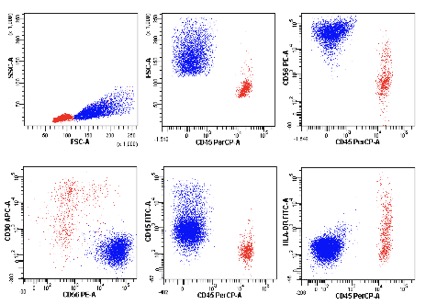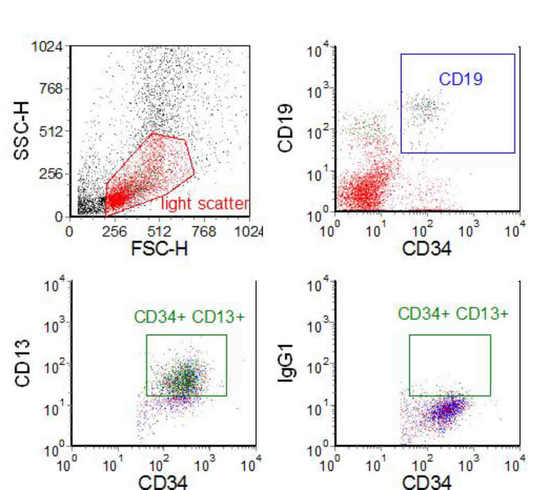flow cytometry results leukemia
If both tissue flow cytometry and histology are required submit one portion of fresh specimen in transport medium or saline for flow cytometry and one portion in 10 formalin for histologic analysis. Flow cytometry FC is a technique used to detect and measure physical and chemical characteristics of a population of cells or particles.

Flow Cytometry Based Protocols For Human Blood Marrow Immunophenotyping With Minimal Sample Perturbation Sciencedirect
Healthcare providers use flow cytometry to predict.

. In order to establish a standardized flow cytometry method for CAR-T monitoring we developed assays that are based on pre-formulated dry antibody panels usefull at all steps of CAR-T cell therapy. These guidelines are a consensus work of a considerable number of members of the immunology and flow cytometry community. Light illuminates the cells as they pass through a narrow channel one at a time and sensors detect whether light is refracted or emitted from the cells.
It has not been cleared or approved by the US. In this process a sample containing cells or particles is suspended in a fluid and injected into the flow cytometer instrument. Spectra viewers will help you determine the amount of spillover and excitation by each laser.
In most cases the lineage can be identified as T-cell B-cell or myeloid and a diagnosis or. Its also used to diagnose and classify leukemia or lymphoma. Results Pre-Formulated Dry Antibody Assays for Flow Cytometry.
How long will depend on the specific types of cells that are being looked for as well as what lab is used. Used to identify specific characteristics of leukemia cells immunophenotyping is another tool that. Go from raw cytometry data to clearly communicated answers quickly confidently and easily.
Peripheral blood flow cytometry is the most valuable test to confirm a diagnosis of chronic lymphocytic leukemia chronic lymphoid leukemia CLL. However flow cytometry can often establish the presence of a clonal B-cell population when other techniques cannot and flow cytometry results usually make certain lymphoma entities extremely likely and others very unlikely. T-cell prolymphocytic leukemia T-PLL is an extremely rare and typically aggressive malignancy cancer that is characterized by the out of control growth of mature T-cells T-lymphocytes.
Food and Drug Administration. Bridging The Gap Between Flow Cytometry and Results. Our comprehensive reagent portfolio includes clinical diagnostic testing kits kits for innovative new approaches to clinical research and single-color reagents for research clinical research or lab-developed.
Therefore flow cytometry is an important integral part of lymphoma diagnosis even in cases where it cannot give a definitive diagnosis. Find answers to most commonly asked questions on intracellular flow cytometry and use of BD Phosflow Reagents. Leukemia Lymphoma View All Blood Cancers.
Find the complete procedure for TCR stimulation of peripheral whole blood cells using BD Phosflow buffers. For decades flow cytometry has balanced these goals to fill a critical need by enabling the measurement of multiple features in single cells commonly to examine complex or hierarchical cellular systems. Flow cytometry identifies cancer cells by finding protein markers on the cell surface.
Please direct any questions regarding this test. Flow cytometry Experts can use a device known as a flow cytometer to analyze cells collected in a sample. The bone marrow aspirate sample is treated with special antibodies that stick only to the cells that have a specific protein on them.
Flow cytometry is a standard laser-based technology that is used in the detection and measurement of physical and chemical characteristics of cells or particles in a heterogeneous fluid mixture. They provide the theory and key practical aspects of flow cytometry enabling immunologists to avoid the common errors that often. After review of the clinical history and morphology a panel of markers is selected for each case by a board-certified hematopathologist.
Three samples that came from patients who had morphologic evidence of malignant disease on biopsy two Hodgkins disease and one large cell lymphoma. Flow Cytometry and Immunophenotyping. Based on how the flow cytometry is set up this approach can find one cancer cell among 100000 bone marrow cells.
FCS Express gets you from raw data to easily-understandable beautifully formatted presentation-ready results more easily and in less time than any other flow cytometry software. Results from flow cytometry have a quick turnaround often less than one day. Flow cytometry is a very technical test and many labs may have only limited ability to process samples.
Flow cytometry is generally used as follow up testing after a complete blood count CBC or white blood cells scan WBC. These flow cytometry assays are produced so that the antibodies are present in dried form at the. Flow Cytometry FC Assay Category.
Specific results will depend on the reason the test is being done. TCR Stimulation and 96 Well BD Phosflow Protocol. Flow cytometric leukemia and lymphoma analysis may aid in identifying the tumor lineage for diagnostic and prognostic purposes.
Results can be available in less than one day. The test may be performed on bone marrow cells. Results showed that in 916 56 percent the diagnosis of lymphoma or cancer could be suspected by flow cytometry alone while 416 were consistent with the final tissue diagnosis of normal or reactive hyperplasia.
This testing can find one cancer cell in 100000 normal cells. Relative brightness tables will give you information on pairing targets with. Choosing the Right Fix.
This process helps determine the. The sample is suspended within a fluid and then injected into the flow cytometer. T-PLL affects older adults with a median age at diagnosis of 61 years and it is more common in men than in.
This assay has been validated pursuant to the CLIA regulations and is used for clinical purposes. T-cells are a type of white blood cell that protects the body from infections. Recently a format for flow cytometry has been developed that leverages the precision of mass spectrometry.
For more in-depth information on Antibody Titration see our Antibody Titration in Flow Cytometry page. There are useful tools that can help with panel design. BD Biosciences flow cytometry reagents truly reflect our scientific leadership in flow cytometry innovation and our 45 years of dedication to providing high-quality products.
The use of flow cytometry has increased over the years as it provides a rapid analysis of multiple characteristics both qualitative and quantitative of the. It confirms the presence of circulating clonal B-lymphocytes expressing CD5 CD19 CD20dim CD 23 and an absence of FMC-7 staining. Polymerase Chain Reaction PCR.
The spread of leukemias to internal organs eg the brain the kidneys or the lungs may be evaluated with imaging tests eg MRI studies CT scans or ultrasound. This is especially true if initial testing showed an increased number of lymphocytes abnormal cell counts or the presence of immature blood cells. Flow cytometry is a methodology which is utilized during analysis of a heterogeneous population of cells according to different cell surface molecules size and volume which allows the investigation of individual cells-FACS together with flow cytometry can measure and characterize multiple cell generations by using highly specific antibodies tagged with.
With chapters on instrumentation useful reagents controls experimental set up and much more this guide enables best practice to be followed and gives practical advice on building multicolor panels with example protocols. This fusion of the two technologies termed. This technique expands trace.
Chemotherapy bone marrow transplantation or. The sample is focused to ideally flow one cell at a time through a laser beam where the light scattered is. This test was developed and its analytical performance characteristics have been determined by Quest Diagnostics.
Flow cytometry results can take up to several weeks to come back. A flow cytometry test may provide valuable insight into whether the tumor cells contain a normal or abnormal amount of DNA and the relative rate at which the tumor is growing. This test is a very accurate indicator in determining the patients exact kind of lymphoma or leukemia.
This flow cytometry guide aims to give you a basic overview of all the important aspects of flow cytometry. Leukemic cells can also be identified by flow cytometry and immunocytochemistry which rely on antibodies binding to and helping to identify malignant cells.

Validation Of A Flow Cytometry Based Method To Quantify Viable Lymphocyte Subtypes In Fresh And Cryopreserved Hematopoietic Cellular Products Cytotherapy

International Clinical Cytometry Society

Chapter 7 Some Clinical Applications Flow Cytometry A Basic Introduction

Gating Strategies For Effective Flow Cytometry Data Analysis Bio Rad Flow Cytometry Data Analysis Flow

Applications Of Flow Cytometric Immunophenotyping In The Diagnosis And Posttreatment Monitoring Of B And T Lymphoblastic Leukemia Lymphoma Digiuseppe 2019 Cytometry Part B Clinical Cytometry Wiley Online Library

Impact Of Flt3 Receptor Cd135 Detection By Flow Cytometry On Clinical Outcome Of Adult Acute Myeloid Leukemia Patients Clinical Lymphoma Myeloma And Leukemia


